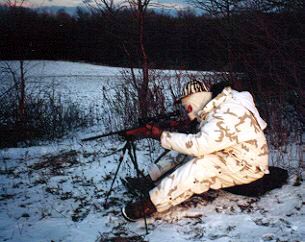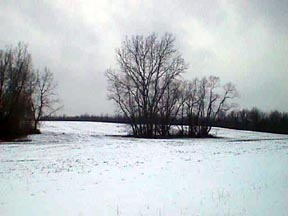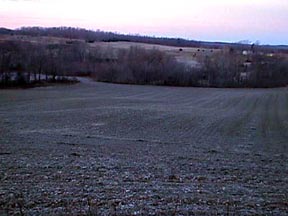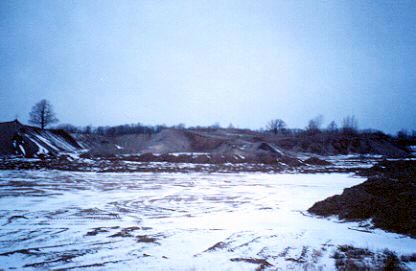PREDATOR HUNTING BASICS
1. WEAPON - This is really a matter of personal choice and availability. Your weapon depends upon the type of terrain you are hunting and the distances you "plan" on shooting. Pelt damage is another factor to consider when choosing a caliber.
Many hunters will use center fire rifles while others utilize shotguns. I personally use a variety of center fire rifles, ranging from a Rem 700 in .222 to a Winchester 22-250.
2. CALLS - A wide variety of calls are available to today's predator hunter. Mouth blown rabbit distress calls have probably accounted for more dead coyotes and fox than all other calls. Hunters in cold climates must take extra precaution when slecting and using mouth calls. Closed reed calls tend to "freeze up" in sub freezing temperatures. After a few minutes of use, they lose their sound and are aggrevating to use. One way to prevent this is to store your call inside of your clothing. It is probably a better choice to purchase and get familiar with an open reed style call. These calls will not "freeze up" as readily as the cloed reed models. No matter which type of call you use, it is always a good idea to secure them on a lanyard. Lanyards will keep your calls secure and organized. The last thing you want to do is fumble around searching for your call when a critter is near.
Many excellent electronic calls are on the market as well. These are nice in that they produce a true and accurate sound which may assist beginning hunters. Which brand and model you choose is a matter of personal choice. Let me say that I prefer a digital call with no moving parts that are going to cause problems. I strongly recommend the Foxpro Digital call.
3. CAMO - With the fox and coyote keen senses, it is important to conceal your self with your hunting environment. You must attempt to blend in with your surroundings, so be sure to pay attention to this detail. Be sure to cover face and hands (especially if you tend to move these often while hunting)

4. WHEN TO CALL - Fox and coyote will tend to feed under the cover of low light. In fact, studies show that predators move most between the hours of 6:00 AM and 6:00 PM. When possible, they will feed at night as this is when their prey species are often mobile. Hunters will see these canines during early morning and pre-dawn hours, hence it is these times that will generate success while calling. In winter months, or during times after a storm, the fox and coyote will be more willing to move about during the day. If your state allows, night time hunting can offer tremendous action.
5. WHERE TO CALL - Red fox tend to be found around wooded farm lots. The gray fox prefers actual woods. Coyotes are everywhere and can be hunted on farms, gravel pits, and woods alike.
I like to set up so that I have a great field of vision so that I can see the quarry from a distance.
CALLING PREDATORS AT NIGHT

First, let's define night as anytime after the sun has gone down and you are now surrounded by darkness. We have called predators with success between the hours of 5:00 PM and 4:00 AM. We cannot truly identify a magic hour, although 12:30 AM has more than it's share of action. Night time hunting is more difficult than daylight hunts for a few reasons...
1.) The hunter's vision is limited and the critters can not be as easily spotted as they approach.
2.) The gear necessary for night hunting is often cumbersome and it is sometimes awkward to carry afield.
3.) The actual shot is more difficult because you can not see the entire target. Many times, you are shooting at the eyes only.
On the other hand, there are some definite advantages of night hunting...
1.) You are hunting during the natural hunting/prowling time of predators.
2.) Hunting pressure is normally low at this time.
3.) Winds are often lower in the night.
4.) On a nice weather night, it's simply a great time to be afield.
If you do not mind missing some sleep, your favorite TV show, and some time with your wife, night hunting may be worth your while!
Here are some of the strategies we employ for success in the dark...
1.)
Pick a good night
Low wind is a must. If the wind is 15 MPH or more, you may want to stay at home. Snow cover is fantastic and will greatly aid in spotting critters as they come in. What about the moon? Some guys do not like a full, bright moon. I say... Bring it on! On a clear night with snow cover, you can see the critters without a light. So long as your set up conceals you, you can still make the shot.
2.)
Set Up
I try to set up where I can see the critters coming in from as far as possible. This will allow me to make any neccessary adjustments with my weapon and lights. I also like to set up on a high spot in the terrain. Again, this gives me a good vantage point to seal the deal. Overlooking a large field that is backed up by a swamp or woods is often ideal.
Wind is critical and must be paid attention to. The predators will almost always circle around you to identify the source of the commotion. Position yourself where you can take a downwind shot. This is imperative! If you have a buddy with you, sit looking in opposite directions. The key here is to sit close enough so that you can communicate with each other. NOTE: Be sure to have a plan for shooting since you are going to be close to each other. Safety must come first!
3.)
Use of The Lights
It will be to your great advantage to use spot lights where permissable by law. Actually, without the use of lights, night hunting would be much less affective and I would save my efforts for daylight. For spotting game, We use hand held 1 million power cordless rechargable spotlights. I bring 3 lights with me in the truck and use the re-charge cord while driving from location to location. When taking a shot, I rely upon my scope mounted 250 yard light that operates with a 6 volt battery. Be sure that your light has a red lens as this will not alarm predators. Additionally, it may be helpful to use some duct tape on lens edging for two resaons...1.) Helps to prevent lens from falling off and 2.) Eliminates sideways glare while operating your light.
Make sure your batteries are fully charged and be sure to have extra batteries or spotlights for a nights hunt. Low temperatures cause the battery life to be reduced so if you are planning a long night of hynting, you must have at least 3 of 4 lights with you.
4.)
Sequence Of A Night Hunt
Here is a typical night time hunt scenario...
- Arrive at location, park a fair distance away from call site. Do not slam car/truck door.
- Give area/field a quick scan with spotlight to check for red eyes ( deer eyes will glow a greenish yellow ). Sometimes fox/coyotes will be fields already and you need to get ready for a quick shot.
- Select your set up and prepare your gear. If using an electronic caller do not place it far from you (remote). The reason for this is because you want to see the eyes as they approach you. If they are not looking at you (the sound source) you may not detect them with the light. If you are hunting with a partner, you should have "lightman" behind shooter or side by side so that you both see the eyes.
- Wait a minute or two, some callers wait up to 15 minutes, for "things to calm down"
- Start calling with call of your choice. As the sound emits, scan the area with your light. Aim the spotlight so that the bottom of the light's halo strikes your intended area. Sometimes, the direct intensity of the beam will scare off the predators. I've seen them scare off and I've seen them keep running in full steam. Raising the beam seems like a safe choice.
- Scan the field a few times in case a critter has come in while you were scanning in a different direction.
- When the red glow of eyes appear, keep light on the eyes (bottom halo) and monitor behavior of predator. If he keeps approaching, all is good. Brace yourself for the shot. If he stops, you have some choices to make. Are you comfortable shooting at the present distance? If so, aim at eyes and pull trigger. If he stops, and you are not calling, call again lightly to entice him. If the predator moves in a direction as if to "wind" you, you need to shoot at first opportunity or pass up on shot all together and try to call him another day/night.
- We normally stay 20-40 minutes or so at each night callilng spot. The bottom line is this... you never know if a fox/coyote is in the immediate area that you are calling. If he is within hearing distance, he should investigate your calling and be seen in the lights. If no predators are present, they may pass through during the course of the night. The question is... How long are you willing to sit in one spot and wait? That is a matter or personal preference.
TEN TIPS FOR NIGHT HUNTING
Here are some little points to consider that may pay off in big dividends...
1.) Watch the Wind: We are not only talking about your set up, but as you approach your stand position. Many predators catch human scent as hunters walk to a set up. Do not walk into a location when your scent is
going to be beating you there.
2.) Crunchy snow: This tip is related to #1. Predators have fantastic hearing. If the snow is noisy underfoot, you will spook game out of the area. For nighttime hunts, make short calling set ups as soon as possible without having to walk far distances. Hunters can then progress into the hunting area knowing that any close vicinity predators have fair opportunity to respond with minimal spooking.
3.) Know your distances: Misjudging distance is a major contributor to missed shots. If you have access to land for night hunting, be sure that you use a rangefinder in the daylight on landmarks such as hedgerows,
trees, and farm equipment. By doing so, you will have some idea of distance when a predator shows up in the darkness of night.
4.) Anticipate the shot: This is not an exact science, but if you can have your gun pointed in the right direction when a predator appears, you will have a major advantage. In the dark, hunters can move to adjust a shot slightly more than during the light. If the predator howls or barks in the distance, you can anticipate his approach better as well. By having your weapon ready, you can concentrate on the shot and not on getting into position without being detected.
5.) Watch the backside: It is believed that for every 1 predator spotted by hunters, 5 more respond without being seen. When hunting with a partner, have one hunter sit facing the opposite direction. It is this hunter who may intercept the predators as they approach the backside of a set up in attempt to wind the situation.
6.) Is your light ready?: Proper spotlight care is vital to its use afield. If you simply snap on a red lens and start hunting, you may be in for trouble. Many times the red lens will not for a secure fit around the light and a white light will leak out. This is enough to scare off predators in many situations. In order to prevent this, take camouflage tape and seal off the area around the lens. Another tip is to place a tube made out of cardboard or pvc around the light. The tube will really direct the light beam and avoid the occurrence of lighting up objects close to the hunter.
7.) A battery of batteries: We mentioned previously that the equipment
involved in night hunting is often cumbersome to carry. Knowing that a single spotlight will not carry enough charge to get you through a night,
the hunter must have a backup plan. One idea is to purchase multiple lights. I did this and still have 3 or 4 at my disposal. However, it gets to be a pain to carry them around and have them in your backpack and even in your vehicle. A more efficient idea is to purchase spare 6 volt batteries and have them with you. Although they have some weight, they are far less bulky.
8.) Hidden Landscapes: The last thing you want to have happen is to call in a coyote only to loose sight of him as he approaches. This usually happens when hunters set up in new areas and do not realize that the terrain has dips or rises in it that will hinder your vision at the moment of truth. It is often beneficial to set up high in the landscape so that you are looking down on the area you are calling.
9.) Proper use of spotlight: The manner is which you use your light may have direct consequence on your hunting success. Number one, scan the
area quickly. Keep the beam moving to catch any eyes of incoming critters. If eyes are detected, keep the light on! Switching the light on and off may alarm or spook the predator. Direct the beam so that the bottom edge of the beam (known as the halo) is on the eyes. Many times a predator will get spooked if the intensity of the main beam is focused directly at the eyes. It is best to play it safe and only highlight the glowing eyes by using the halo to your advantage.
10.) After the shot: The work is not complete after the trigger has been pulled.
Hopefully, you will hear the telltale “whump” of a hit. Even so, keep calling and scanning the area for other predators as it is not uncommon to have them come in as pairs. Make a mental note of where you shot, so that you will have an easier time of finding the downed critter. Better yet, have a partner keep a light on the critter as you go to retrieve it.
 ABOVE: THIS IS WHAT YOU WANT TO SEE!
PICTURES OF SOME SET UPS
ABOVE: THIS IS WHAT YOU WANT TO SEE!
PICTURES OF SOME SET UPS

Here is a nice calling set-up that regularily produces predators. The fox typically respond to calls by coming in from woods on right side of pic and travelling to the "oasis" seen in center. I sit about 75 yards away which offers me a nice shot.

Here is a newly acquired hunting spot. I call it the "Valley of the howls" because when I was there a brush wolf was in a howling battle with a pack of coyotes. My FoxPro caller emitting cottontail distress brought in the coyote now known as "Mr. Mange", who can be seen in our photo gallery.

Gravel pits are always nice because I feel as if I'm in a western desert when I 'm really in New York. This location provides me with 360 degrees of vision. I harvested the coyote that is featured on the main page of our website right here.